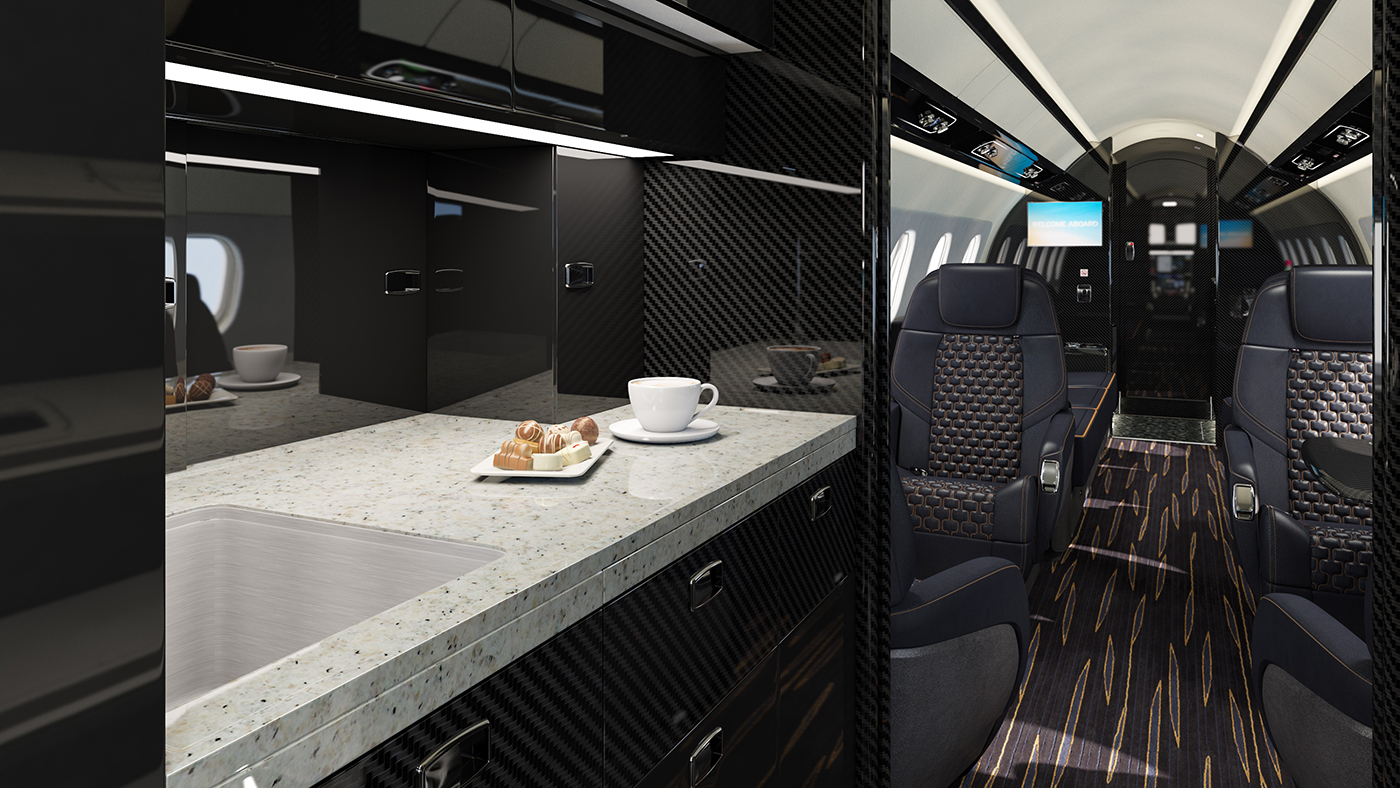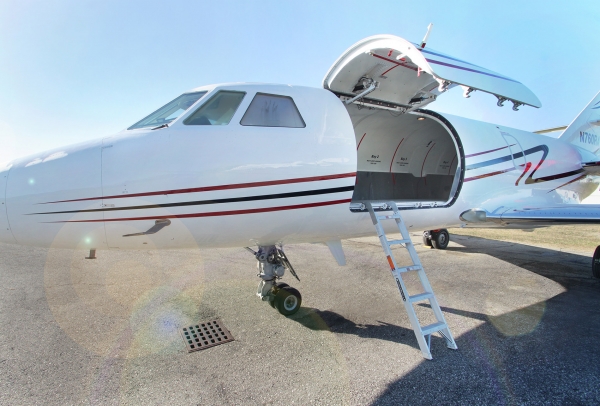[ad_1]
Introduction:
The story of the 50-seat regional jet, produced by Canadair and Embraer-and preceded, to a lesser degree, by the Fokker F.28 Fellowship and the British Aerospace BAe-146-was, in many ways, Long Island MacArthur Airport’s story, since the type finally facilitated major carrier aligned hub feed service. Representing larger airline reach to smaller and secondary airfields, it offered the same speed, block times, and comfort as the traditionally larger mainline jets, plugging the gap between them and the 19- to 50-passenger turboprop aircraft that were too small and too slow for many of these sectors.
The need, in great part, was created by the airline deregulation bred rise of the hub-and-spoke route system in the US. Funneling and feeding passengers to the higher-capacity aircraft of the majors, such as American, Continental, Delta, and United, from longer, but thin segments operated by regional airlines that bore the majors’ two-letter code and livery, the originally independent commuter carriers rapidly expanded themselves, primarily because of this new type of jet. It was the right aircraft at the right time and led to what has been called the “regional jet revolution.”
Not only were the regional jets the most cost-efficient way for airlines to link hundreds, if not thousands, of communities to airport hubs and global airline networks,” according to Bombardier Aerospace (which subsequently acquired Canadair), “these innovative aircraft enhanced the passenger travel experience and provided regional airlines with increased traffic, revenues, and greater market share. To further increase traffic growth, the idea of using the Canadair Regional Jet to fly between ‘spoke’ cities was promoted. Every new spoke city increased the number of connecting passengers flying to a regional airline’s mainline partner’s hub. These additional routes provided passengers in small communities with more flight options.”
This certainly occurred at Islip’s Long Island MacArthur Airport.
“There are literally hundreds of markets out there that could not support regular jet service, but 30-, 50-, and 70-seaters can now bring jet comfort and economic service,” commented Doug Blissit, once Delta Air Lines’ vice president of network analysis. “The regional jets are a phenomenal economic transformation of the industry. The vast majority of deployments have been to extend the reach of the hubs with more economical aircraft.”
Over and above the type’s cooperative nature, it also had a competitive side. It could be considered a tool that attacked major airlines’ hub-and-spoke fortresses, enabling smaller carriers that began as traditional turboprop commuters to penetrate the cracks in the majors’ armor, forging new point-to-point routes that did not need hub feed for adequate load factors.
Early Regional Jet Operations:
Perhaps the earliest regional jet in the western world, which eliminates the Russian tri-engine, 27-passenger Yakovlev Yak-40 from the discussion, was the Fokker F.28 Fellowship.
The popularity of its high-wing, twin-turboprop, 40-passenger F.27 Friendship, like a compass needle pointing in the direction of a pure-jet complement that would offer higher speeds and hence decreased block times, led to the development of the F.28 itself.
Announced in April of 1962, it was intended for short-field operations, but offer higher seating for 65 in a fuselage wide enough for five-abreast arrangements. Appearing similar to the mainline jets, such as the British Aircraft Corporation BAC-111 and the McDonnell-Douglas DC-9, it featured a low-mounted, compoundly swept wing on its leading edge, two aft-mounted Rolls Royce RB.183 Spey Junior turbofans, a dorsal fin, and a t-tail, yet retained simplicity by eliminating any leading edge devices. Unique to its design was a hydraulically actuated petal airbrake that formed the aft end of the fuselage. Extendable to varying degrees, it facilitated steep, but slow and controlled descent profiles.
Aside from financial backing provided by the Dutch government, the program’s risk sharing came from Short Brothers of Belfast, Northern Ireland; HFB and VFW of Germany; and AiResearch, Dowty Rotol, and Goodyear.
Three prototypes respectively first flew on May 9, August 3, ad October 20 of 1967 and the first production version, the F.28-1000, was delivered to launch customer LTU of Germany on February 24 two years later. As had occurred with the F.27, sales could be counted in single digits, since the F.28 was usually the largest type in a small airline’s fleet.
A stretched version, the F.28-4000, featured a 97.2-foot overall length and an almost 12-foot greater wingspan of 82.3 feet. Powered by two 9,850 thrust-pound Rolls Royce Spey 555-15H turbofans, it had a 73,000-pound maximum takeoff weight, a 530-mph cruising speed at 21,000 feet, and maximum payload-to-fuel ratio ranges of 1,162 to 2,560 miles. Although it accommodated 79 five-abreast, single-class passengers, six more, for an 85-total, could be carried at a 29-inch seat pitch with the installation of an additional overwing exit on each side.
The type factored into Piedmont’s Islip operation.
Piedmont itself inaugurated its scheduled aerial link as far back as February 20, 1948 with flight 41. Departing Wilmington, North Carolina, at 0700, its DC-3 made the multiple-hop journey to Pinehurst, Charlotte, Ashville, the Tri-Cities, Lexington, and Cincinnati. Two other aircraft of the type and 250 employees constituted its metal and human backbone.
With progressive expansions, particularly with route extensions to Atlanta, it initially fed the flights of Delta and Eastern, significantly growing until it became a US major in its own right. Perhaps symbolic of its prestige was both its literal and large-airline image arrival in New York in 1966.
Profits mounted: $1 million in 1965 and almost double that two years later. Erecting its first hub in Charlotte, North Carolina, it radiated its reach to major cities, such as Boston, Pittsburgh, Tampa, Miami, Dallas/Ft. Worth, and Denver, exceeding, in the number of passengers carried, Eastern Airlines’ traditional Charlotte stronghold.
Operating 727-100s, 727-200s, and 737-200s-the latter its short- to medium-range workhorse-it advertised in its October 31, 1982 system timetable, “We make it easy to get around to over 80 cities.”
Hubs were subsequently established in Baltimore and Dayton and widebody 767-200ERs eventually reached the West Coast and Europe.
By 1987, Piedmont operated a 177-strong fleet to some 235 destinations, carrying 23 million passengers, and thus became ripe for USAir’s $1.6 billion acquisition.
Capacity, particularly of the 65-passenger F.28-1000, ensured frequency at Long Island MacArthur Airport.
Of the five daily departures it dispatched to its Baltimore hub, the morning and evening ones were conducted with 128-passenger 737-300s; the mid-morning and mid-afternoon ones were flown with Henson, The Piedmont Regional Airline’s 37-passenger DHC-8-100s; and the noon sector was conducted with the F.28-1000, enabling it to “right-size” its equipment according to time of day, capacity, and demand.
When Piedmont acquired New York State-based and -concentrated Empire Airlines in 1986, along with its Syracuse hub and 85-passenger F.28-4000s, it deployed the type from Islip to feed its significantly developed Charlotte hub.
Another early regional jet was the British Aerospace BAe-146.
The ultimate design response to a need for a feeder or regional aircraft, it progressed through numerous iterations, including those of the high-wing, twin-turboprop DH.123 proposed by de Havilland and a low-wing one with aft-mounted engines until it arrived at the HS.146 of Hawker Siddeley with Avco Lycoming ALF-502 high bypass ratio turbofans. Because they did not generate the required thrust for the envisioned aircraft, only the use of four, pylon-mounted to the high wing’s underside, could ensure the needed performance and range.
Although the type’s official, 1973 launch appeared promising, the subsequent world recession, rising oil prices, and escalating development costs, rendered it ill-timed, resulting in its termination in October of 1974. Low-key development nevertheless continued.
After de Havilland and Hawker Siddeley were combined into the nationalized British Aerospace, and it conducted its own design and market review, it was government granted full-scale program development on July 10, 1978.
Final assembly took place at Hatfield.
Sporting, like the F.28 Fellowship, a t-tail and an aft petal, fuselage-forming airbrake for steep approaches, it deviated by having a high wing, also without leading edge devices, and the four turbofans. While its cabin was wide enough for six-abreast seating, most carriers chose five.
First flight of the BAe-146-100 from Hatfield occurred on September 3, 1981. Two successively higher-capacity, stretched versions, the BAe-146-200 and -300, followed.
The former, which first took to the air on August 1, 1982, featured a 93.10-foot length and an 86-foot span with a 15-degree sweepback and tabbed, trailing edge Fowler flaps. Up to 112 single-class passengers could be accommodated at a six-abreast, 29-inch pitch. Its maximum gross weight was 93,000 pounds and range, with a full payload, was 1,130 nautical miles.
The BAe-146 was inaugurated into service with Air Wisconsin on June 27, 1983.
Presidential Airways, founded by Harold J. Pareti in 1985 and headquartered in Washington, was the only operator of the type into Islip, maintaining a fleet of eight BAe-146-200s, in addition to its 737-200s. Connecting Long Island with its Dulles International hub, it later operated as a Continental Express and United Express code share carrier, respectively feeding each of its major’s flights in Washington.
Later Regional Jet Operations:
The first next-generation regional jet took form as the Canadair (later Bombardier) CRJ.
Aside from developing all-new designs, aircraft manufacturers of potential, low-capacity pure-jets had two options: scale down an existing mainline aircraft, such as the DC-9-10, which would have incorporated too much structural weight for its market, or scale up an aircraft. Those that fell into the latter category were business jets, although their narrow fuselages rendered them less than ideal for such a commercial application. Because of the wide cabin of its own CL-600 Challenger, which first flew in 1978, Canadair was able to choose the latter option.
Initially envisioned as incorporating a simple stretch with capacity for 24 four-abreast passengers and designated CL-600E, it was first publicized in 1980, but cancelled its plans to proceed with the version the following year. In 1987, or a year after Canadair was acquired by Bombardier, the small regional jet concept was reconsidered, leading to its launch in 1989.
A more ambitious version than originally considered, it introduced a 19.5-foot stretch, attained by means of forward and aft fuselage plugs, additional overwing emergency exits, a reinforced wing with increased fuel capacity, and two aft-mounted General Electric CF34 turbofans, in which guise it first took to the sky as a prototype on May 10, 1991. After a three-airplane flight test program, it received its FAA certification on October 29 of the following year, entering service with launch customer Lufthansa CityLine, which used it to provide both point-to-point and hub-feed service to Western European destinations from Dusseldorf, Frankfurt, Hamburg, and Munich.
Exuding what one pilot called a “sexy look,” the initial CRJ-100 version featured a pointed nose, an 87.10-foot length, a 69.7-foot, winglet-attached span with a 520.4-square-foot area and trailing edge-only flaps, two 9,220 thrust-pound CF34-3A1 thrust reverser provisioned turbofans, and a t-tail. Fifty four-abreast passengers could be accommodated in slimline seats in a cabin with enclosed overhead storage compartments, a galley, and a lavatory.
Payload was 13,500 pounds, gross weight 53,000 pounds, and range 1,650 nautical miles.
The succeeding CRJ-200, powered by CF34-3B1s, offered greater range, lower fuel consumption, and increased cruise speeds and altitudes.
Sales of both types totaled 1,054.
Headquartered at Cincinnati-Northern Kentucky International Airport, Comair was Long Island MacArthur’s first modern regional jet operator.
Commencing service as an airline in 1977, it initially touched down in Akron/Canton, Cleveland, and Evansville with eight-passenger, piston powered Piper Navajos, succeeding them with 18-passenger turboprop Embraer EMB-110 Bandeirantes.
Accepted as a Delta Connection carrier and operating in its livery after its establishment of a Cincinnati hub in 1984, it significantly expanded, soon acquiring Fairchild Swearingen Metro, Shorts 330, Embraer, EMB-120 Brasilia, and Saab 340 equipment. Orlando became its second hub.
As the US launch customer for the Canadair Regional Jet, it operated 163 of the type, including 63 CRJ-100ERs, 37 CRJ-100LRs, 37 CRJ-200ERs, and 27 CRJ-700LRs, by 2005.
Delta had acquired 20 percent of Comair’s stock in 1996 and the remainder of it three years later.
The type was instrumental in its service inauguration to Islip, providing three daily morning, afternoon, and evening round trips to Cincinnati so that passengers could connect to its own and partner-Delta’s flights. That link opened the rest of the country and parts of Canada to Long Island.
Another Canadair Regional Jet operator from MacArthur, which was also a Delta Connection carrier, was ASA Atlantic Southeast Airlines.
Inaugurating independent scheduled service from Atlanta to Columbus, Georgia, with de Havilland of Canada DHC-6 Twin Other aircraft on June 27, 1979, it progressed through another turboprop, the EMB-110, before acquiring pure-jet BAe-146-200 and CRJ-200 types, which fed Delta’s Atlanta hub after it had concluded its own two-letter marketing agreement with it. As had occurred with Comair, ASA was appendaged by increasing stock purchases until Delta wholly owned it.
Cincinnati, reached in 2002, was its 100th destination and in 2003 it took delivery of its 100th regional jet. By 2011, it operated 112 CRJ-200ERs, 46 CRJ-700ERs, and 10 CRJ-900ERs.
Islip was connected to its own and Delta’s extensive Atlanta hub with three daily ASA-operated CRJ-200 round trips as of August 1, 1999. Comair later also served the route.
Another Canadair Regional Jet operator to Islip was Air Wisconsin, which was branded US Airways Express and reinstated the link lost due to Washington Reagan National slot restrictions, when its inbound aircraft, arriving at 1250 on March 25, 2012, was granted with a water curtain on MacArthur’s ramp.
Re-departing at 1328, it became the first of two daily CRJ-200 round trips. Although it was highly endorsed by law makers, it was short-lived.
The Canadair Regional Jet’s counterpart-if not competitor-was the Embraer ERJ-145.
Harnessing its power from never-before-available engines that enabled it to operate in primarily untapped markets, it sought to outweigh the higher fuel consumption of them as opposed to that of the traditional turboprop’s by increasing the daily utilization its shorter block times afforded, coupled with their greater passenger acceptance.
Unlike Canadair’s CL-600 Challenger business jet, it used the EMB-120 Brasilia as its inspirational foundation, introducing two fuselage plugs and a redesigned wing, with an extended leading edge chord, a slight sweepback, and winglets, but replacing its turboprop engines with pure-jet ones encased in pods. The t-tail was retained. It was initially designated the EMB-145 Amazon.
The Allison GMA-3007 turbofan, producing 7,100 pounds of thrust, with potential for up to 10,000, was selected in early-1990.
Iterations entailing reduced lengths, increased spans, greater fuel capacities, higher weights, and improved performance, led to the definitive ERJ-145 that first flew on August 1, 1995. Accommodating 50 single-class, three-abreast passengers with a partial step-down aisle at the very front of the cabin, it had a 12,755-pound payload and a 48,501-pound gross weight. It was first delivered to launch customer ExpressJet Airlines, operating as Continental Express, the following year, providing the capacity, speed, and range to match the demand on longer, thin routes to both feed its own flights and those of Continental.
“With its hub at Cleveland Hopkins International Airport, Continental Airlines is the largest airline in northeast Ohio, with more than 250 daily departures to nearly 80 cities,” according to United Airlines’ March 29, 2004 Corporate News. “With one of the youngest fleets of airplanes in the United States, Continental and Continental Express offer convenient, high-frequency service from Cleveland Hopkins to major business centers, including Boston, New York (Newark Liberty, La Guardia, Kennedy, White Plains, and Islip), Washington (Reagan National, Baltimore-Washington, and Dulles), Chicago (O’Hare and Midway), Houston, and Atlanta.
Like other regional airlines, ExpressJet itself was the amalgamated result of several turboprop commuter carriers-among them Bar Harbor Airlines of Bangor, Maine; PBA Provincetown-Boston Airlines of Hyannis, Massachusetts; Rocky Mountain Airways of Denver, Colorado; and Brit Airways of Terre Haute, Indiana, all of which flew on the latter’s operating certificate.
It inaugurated ERJ-145 regional jet service on September 4, 1998 and ultimately became the type’s largest operator of all three versions, including the smaller, 37-passenger ERJ-135 and 44-passenger ERJ-140.
Its three daily morning, afternoon, and evening Islip-Cleveland frequencies, bearing “CO” flight numbers, linked Long Island with the rest of the country.
Another MacArthur Embraer regional jet carrier was American Eagle.
Like Continental Express, the American Eagle concept, which was unveiled in late-1984, resulted from American Airlines’ inability to economically serve secondary and tertiary markets with its mainline jets. It grew rapidly, feeding its hubs and progressing from turboprop to pure-jet equipment. The first officially designated American Eagle flight, from Fayetteville, Arkansas, to Dallas, took place on November 1 when one of its Metroflight’s 14 Convair 580s, powered by two 3,750-shp Allison 501-D13H turboprops, touched down at American’s southwest hub. The aircraft, converted from piston propelled CV-240s, -340s, and -440s, were eventually replaced with Saab 340s.
Second to join the fold, also that year, was Poughkeepsie, New York, based Command Airways, which operated Beech 99s, DHC-6 Twin Otters, Shorts 330s, Shorts 360s, and ATR-42s.
Simmons, the third, deployed Japanese NAMC YS-11s, Shorts 360s, ATR-42s, and ATR-72s from Chicago-O’Hare, and Wings West, the fourth, dispatched C99s, Fairchild Swearingen Metros, Jetstream 31s, and Saab 340s to West Coast destinations.
Lastly, Puerto Rico based Executive Airlines jumped into the pool on September 15, 1986, operating CASA C-212-200 Aviocars, Shorts 360s, and ATR-72s.
From Islip, it operated a midday ERJ-145 to Chicago-O’Hare, supplementing American’s morning and evening MD-80s, and replaced its four daily, 34-passenger Saab 340s (which had once flown in Business Express colors before AMR, Inc., acquired it and folded it into the American Eagle brand) with an equal number of 37-passenger ERJ-135 frequencies.
Yet another Long Island MacArthur American Eagle ERJ-145 operator was Piedmont, which traces its origins to Henson Airlines.
Founded in 1961 by Richard A. Henson, an aviation pioneer and Fairchild Aircraft test pilot, it planted sedentary roots as a fixed base operator in Hagerstown, Maryland, designated “Henson Aviation,” yet initiated scheduled service of its own from there to Washington in 1962 under the “Hagerstown Commuter” name.
Consummating a code share agreement with Allegheny Airlines five years later and replacing that carrier’s own service in Salisbury, Maryland, it expanded to Philadelphia, Baltimore, and Washington, boarding its one millionth passenger in 1977 and acquiring its first quad-engine, 54-passenger de Havilland of Canada DHC-7 two years after that.
Purchased by Piedmont Airlines in 1983, it was rebranded “Henson, The Piedmont Regional Airline.”
The following year it took delivery of the first 37-passenger DHC-8-100 and by the end of 1987, it served 38 destinations in ten states, as well as in the Bahamas.
After the 1989 merger with USAir, Henson operated as a USAir Express and later US Airways Express carrier, but was renamed “Piedmont Airlines” four years later to retain its original identity. American Airlines, which purchased US Airways in 2013 and rebranded it American Eagle, maintained the philosophy.
Today, Piedmont/American Eagle operates three daily ERJ-145 frequencies, departing Islip at 0710, 1035, and 1858 to Philadelphia, one of USAir/US Airways’ former hubs. Return flights arrive on Long Island soil at 1007, 1833, and 2221.
Both ASA Atlantic Southeast Airlines and Comair operated the larger CRJ-700 into Islip.
The result of Bombardier’s first attempt to offer a higher capacity version in order to more effectively compete with the Fokker F.70 and the Avro International RJ70, both 70-seaters, it officially launched the program in January of 1997. Based upon the original CRJ-200, it introduced a slightly wider fuselage with a 106.8-foot overall length; a larger wing, with a 76.3-foot span and 760-square-foot area; leading edge slats to increase low-speed lift and reduce takeoff runs; 13,790 thrust-pound CF34-8C5B1 turbofans; a lower floor for increased cabin headroom; raised passenger windows; a single-class capacity of 78; and 18,055- and 75,000-pound maximum payloads and gross weight weights.
First flying on May 27, 1999, it entered service with Brit Air two years later, retaining the same type rating as that of its smaller capacity predecessors.
Its extended range CRJ-700ER had a 1,504-nautical mile capability and a 448-knot/515-mph/Mach 0.78 cruise speed.
Regional Jet Snapshots in Time:
Because of demand, the need to adjust capacity, scheduling, and, in some cases, replace one aircraft type with another, any attempt to discuss Long Island MacArthur Airport’s regional jet operations can only be done as snapshots in time.
During the latter portion of 1988, for instance, which can be considered its early regional jet period, Presidential Airways operated its BAe-146-200s to Washington-Dulles, while Piedmont “right-sized” its aircraft to maintain frequency, sandwiching the 65-passenger noon F.28-1000 between morning and evening 737-300s and mid-morning and mid-afternoon Henson DHC-8-100s.
1998, which can be considered the dawn of the next-generation regional jet era, saw Long Island connected to Delta’s Atlanta and Cincinnati hubs and Continental’s Cleveland one with 50-seat CRJ-100s, CRJ-200s, and ERJ-145s, respectively operated by Comair, ASA, and ExpressJet.
The number of daily departures included three Comair/Delta Connection CRJ-100s to Cincinnati, two American Eagle ERJ-145s to Chicago, two and later three ExpressJet/Continental Express ERJ-145s to Cleveland, and three ASA/Delta Connection CRJ-200s to Atlanta.
During its first month of regional jet operations, the latter airline carried 6,980 passengers, making it the airport’s third-largest tenant in terms of boardings.
By December of 1999, eight of the 37 daily pure-jet flights, or 19 percent, were conducted with the new breed of Canadair and Embraer regional jets. By March of 2000, the monthly regional jet passenger total was 16,210-that is, 6,107 carried by ASA, 6,831 by Comair, and 3,212 carried by ExpressJet.
In August of 2002, American Eagle replaced its four Saab 340 flights to Boston with ERJ-135s, providing American Airlines hub feed, and by the fall ASA and Comair upgraded two or their three Atlanta and Cincinnati frequencies to larger capacity CRJ-700s.
Last Regional Jet Service Inauguration:
The latest carrier to enter the Long Island market with the regional jet was Elite Airways.
Founded, as reflected by its name, to offer a quality travel experience in 2016, it entered the arena as a US Part 121 air carrier, transporting sports teams and executives on both scheduled and charter services on northeast-to-Florida routes with one CRJ-100, five CRJ-200s, and five CRJ-700s.
Limited, twice-weekly CRJ-700 services, from Islip to Portland, Maine; Myrtle Beach, South Carolina; and Melbourne, Florida, were inaugurated on June 17, 2016. But lower than expected load factors prompted it to twice pause, between January 15 and February 16, 2017 and April and July of that year, to reconsider its strategy.
While the second suspension turned into an unanticipated 16-month one, it finally reappeared on the scene on September 6, 2018, this time routing a Thursday and Sunday CRJ-200 to Melbourne. Designated Flight 7Q 21, it departed at 0800 and arrived in the sunshine state at 1045. After a 45-minute turnaround, it redeparted at 1130 for Bimini, Bahamas, becoming Islip’s first one-stop link to it.
“The route is designed so that passengers from Islip can book a flight to Melbourne only or stay on board with connecting service to Bimini,” according to Rebecca Emery, an Elite Airways public relations executive. “It is the closest Bahamian island to the US with miles of seclude beaches, four-star hotels, and the Resorts World Bimini Casino and Marina.”
The return flight, 7Q 23, departed Bimini at 1330, but required US Customs and Border Patrol preclearance. Landing in Melbourne an hour later, it next operated as 7Q 24, taking off at 1600 and touching down at MacArthur at 2045.
Low load factors once again caused its discontinuation, leaving Piedmont/American Eagle’s ERJ-145s to Philadelphia as Islip’s only remaining regional jet operations at the dawn of 2020.
[ad_2]
Source by Robert Waldvogel










